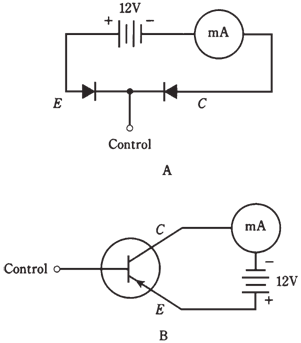Biasing for current amplification:
Because a small change in base current, IB, results in the large collector-current (IC)
variation when bias is just right, a transistor can operate as the current amplifier. It may be more technically accurate to say that it is current fluctuation amplifier, because it is the magnification of current variations, not absolute current, that is important.

Figure-- At point A, simple PNP circuit using dual-diode modeling. At point B, the actual transistor circuit.
If you look at the given figure closely, you will see that there are some bias values at which the transistor will not give current amplification. If E-B junction is not conducting, or if transistor is in saturation, curve is horizontal. A small change of the base voltage, EB, in these portions of curve, will cause no up and down variation of IC.
But if transistor is biased near middle of straight-line part of curve in the figure, the transistor will work as current amplifier.